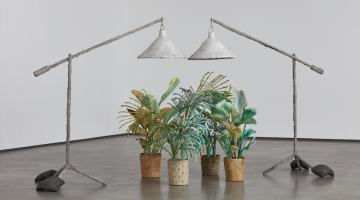Joseph Beuys – I Like America And America Likes Me from Ana Fernandes on Vimeo.
According to Curator Jorg Schellmann one of Joseph Beuys’ most powerful action events was Titus Andronicus/Iphigenie, performed on 30 May 1969 in the Theater am Turm in Frankfurt, for Experimenta 3. Wearing a fur coat, Beuys appeared on a darkened stage with a shining white horse. He used the myth and the drama of Iphigenia to draw attention to the freedom and the creativity of the individual. Schellmann has curated the current exhibition up at Galerie Thaddaeus Ropac’s Paris Pantin location that examines the ephemera, sketches, and the history around this action while brining the action back into the contemporary viewers experience by including a white horse inside the gallery, not a first for Beuys having wild animals as part of an action like his most famous example “I like America and America likes me”, performed in 1974 at René Block Gallery on East Broadway where he shared a room with a wild coyote, for eight hours over three days.
The addition of the horse to this exhibition at Paris Pantin seems to be a part of the growing conversation around re-creating or doing contemporary responses to past actions/ performances and how curators can be put in very volatile positions with the artists’ estates rightfully protecting and managing such (sometimes though in a quite overbearing manor) and secondary market dealers who stand to make or loose a lot of money off of throwing threats of legal action around. I for one believe that in order to illustrate specific actions and performances of past generations to a contemporary viewer that slight appropriate theatrics (the horse) can really help bring back the artists’ true intentions to the piece. I do know that a lot of conceptual artists who are still alive are not ok with this, but what happens when they are not around to perform or have no desire to perform a very physical action (Burden “Shoot” for example) that they were able to perform in their youth. Perhaps all major performance artists should be required to fill out some legal forms detailing how (for the importance of art education of future generations) their pieces may be re-created or responded to. I guess John Baldessari’s “Cal Arts Post Studio Art: Class Assignments (optional), 1970” (one of many examples) has already made the re-creation the action itself.




